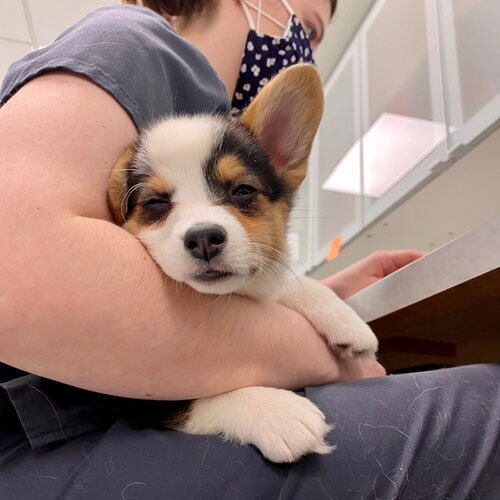5 Emergencies That Can’t Wait
with Dr. Andrew Bean
While no pet parent ever wants a visit to the emergency vet, sometimes it is unavoidable. While occasionally the recommendation is due to limited capacity at your primary vet, sometimes it’s because an ER will be better equipped to manage a critical case due to specialized equipment and a triage based schedule. In this article, our Medical Director Dr. Andrew Bean will go over five pet emergencies that can’t wait.
We recommend local emergency hospitals such as Veterinary Emergency Group, for most situations or MedVet Chicago if your pet has special needs such as cardiology or neurology. If your pet is alert, responsive and appears relatively comfortable, feel free to call us or an ER hospital for recommendations on next steps. Dr. Laura Kozwakski, Veterinary Emergency Group Medical Director, notes, “I think the top emergencies we are suited for are any episodes of vomiting/diarrhea, issues with urination, active bleeding, and toxicities. When in doubt, give us a call and speak to a doctor about whether or not your pet needs to be seen.”
In the event of a true emergency, you should immediately head for an emergency veterinary hospital. Dr. Andrew Bean, Medical Director at Boulevard Veterinary, discusses five emergencies that should be addressed without delay.
Gastric Dilatation Volvulus (GDV) or “bloat” is a condition where the stomach fills with air and then twists and turns on itself which can cause a loss of circulation to the stomach and spleen. This is a life threatening emergency that has a higher risk of occurring in deep chested breeds like Greyhounds, German Shepherds, Great Danes, or Weimaraners and usually requires immediate surgery to correct. The most common signs to look out for would be bloating of the stomach or abdomen, unproductive retching, and abdominal pain. Sometimes their abdomen will be sensitive to touch, but more often abdominal pain can present as a hunched posture or the inability to get comfortable and settle.
2. Urinary obstruction of a male cat, typically referred to as a “blocked” cat, is where there is a plug of either mucous, crystals, or stones that blocks the urethra in a male cat and prevents them from urinating. Typically the signs you would see at home would be straining to urinate, vocalizing while trying to urinate and blood in the urine. This can progress by causing the cat to become very lethargic and experience loss of appetite. Urinary blockage can cause them to get very sick and if untreated long enough can cause severe kidney disease and cardiac abnormalities. Most of these episodes are NOT due to a UTI (infection) but are usually a sterile inflammation of the bladder due to stress. The best way to prevent it is enticing them to drink a lot of water, adding more litter boxes, and addressing any underlying stressors in the home. See Litter Box 101 here.
3. Intoxications can come in many different forms but the most common and severe intoxications would be xylitol (artificial sweetener common in gum), lilies, grapes, chocolate, antifreeze, over the counter human pain medication, and rat poison. You can learn more about toxicity here. The clinical signs from these can vary but most will cause liver or kidney failure so look for general lethargy, vomiting, and not eating - you don’t want to wait for these symptoms to appear before seeking veterinary attention if at all possible. If an ingestion is suspected, the best thing a pet owner can do is to try to determine the exact amount ingested and call the Animal Poison Control Center who can give them specific instructions for help. Even if you go to the vet, most veterinarians will want to know what Animal Poison Control recommended so it never hurts to call them as your first step. For any ingestion, early detection and intervention is going to be the most helpful. Specific treatment depends on what the pet ate but can range from inducing them to vomit or more intensive hospitalization.
4. Difficulty breathing is another thing that can have a variety of causes but should be seen by a vet immediately. It could be due to something stuck in the windpipe, heart issues, trauma, or infection (pneumonia). What to look for at home that indicates respiratory distress would be having loud exaggerated breathing, open mouth breathing in a cat, using their abdomen to help breathe and extending their neck. Brachycephalic breeds (smooshed face) like Frenchies, Boston terriers, English bulldogs are predisposed due to their anatomy. Treatment often involves giving supplemental oxygen and treating the underlying cause.
5. Complete paralysis or loss of feeling in the back legs should be seen ASAP. Warning signs can include a “wobbly” gait or toe dragging. The most common cause in dogs is a bulging disc in their spine, while in cats it can be related to a clot that has formed in their back legs from heart disease. For dogs they can sometimes be treated with pain meds or surgery and the sooner they are evaluated the better chance they have to recover completely.
We hope you found these tips useful and that they help you keep your pet happy and healthy! If you have any questions, don’t hesitate to ask us. As always, we’re here for you and your pets.
Sincerely,
The BLVD Team
If your pet requires care after office hours, please contact one of these emergency hospitals:
Veterinary Emergency Group Chicago
755 W North Ave
Chicago, IL 60610
(312) 757-5444
3305 N California Ave
Chicago, IL 60618
(773) 281-7110
3927 W. Belmont Ave
Chicago, IL 60618
(773) 516-5800






